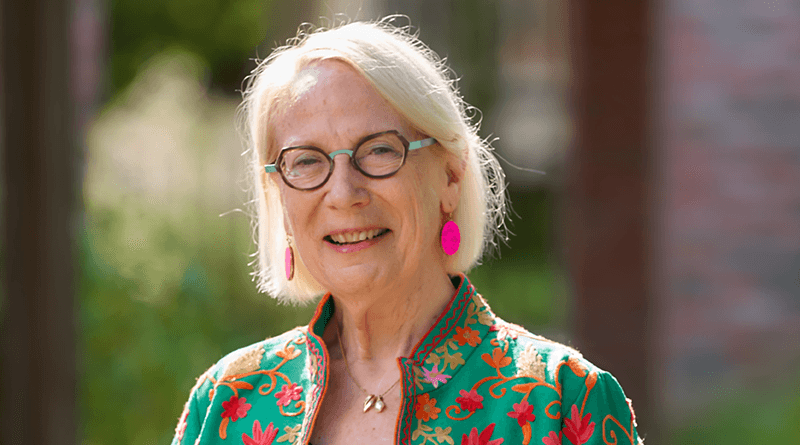Suzanne Mayer Community Activist
Rochester icon evolves from corporate consultant to community activist, fighting to improve Rochester neighborhoods
By John Addyman
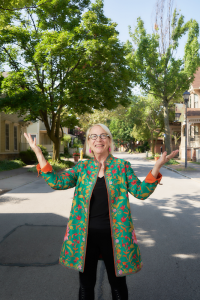
It isn’t hard to picture.
A group of people sits in someone’s living room in Rochester. There are light snacks throughout the room, coffee and soda water bottles available, and based on body language, everyone’s interest level is high.
There’s an issue that has brought them together. A problem. A nuisance. A need.
After several meetings just like this one, people have finally decided what they really want.
Now, how to get it? Whom to approach? Who to talk to? What’s the first step? What’s needed? Who is going to do what?
“How do we get started?” someone will finally ask the group.
“I know someone,” a voice will say. “I’ll check with Suzanne Mayer to see if she’s available to help us.”
That’s pretty much how Mayer, 72, finds herself getting involved.
She is a consultant who has morphed her experience as a corporate problem-solver with a set of finely honed discovery and process skills to become a community activist.
She is increasingly well known in Rochester as someone who can get to the core of a problem and help people devise a way out.
And people have no problem finding her.
Neighbors catch her in the garden. Friends tap her shoulder at the Genesee Valley Club.
Acquaintances look for her in one of the coffee houses she frequents when she wants some respite to think, pull up a chair and say “We have a problem you might be able to help us with. Can we talk?”
At her dining room table, “Where the work gets done,” she says, Mayer uses her hand to symbolically chop through issues and patterns, segregating, illuminating and gathering.
She is the sum of her work challenges and education, and knows it.
“Everything I’ve done was a formative experience,” she explains. “You always had to figure out a way of getting in.”
Bright, quick, self-effacing with a girlish laugh, and focused like a beam of light when necessary, Mayer has been gifted with a blessedly varied career filled with impossible opportunities because apparently one of the hardest words for her to say is “no.”
Married in her last year at St. Lawrence University, the former Suzanne Blumenstock, a farm girl introvert, fell for a city dwelling doctor-to-be, Sandy Mayer, an easygoing and loving extrovert.
They started married life — and his med school — in Belgium, where she supported the two of them by teaching math, biology and sex education in an American Catholic school run by Irish nuns.
“I taught kids from all over the world,” she said. “I taught them to love math. I tutored people from the embassy. The kids moved around a lot. I did a lot of coaching.”
The Mayers came back to the U.S., dropping in Syracuse where Sandy started his residency in family practice. They moved to Akron, Ohio, where Sandy started a pediatrics residency and Suzanne started a job as a claims processor for Aetna.
Back to Rochester they came two years later, in 1976, where Sandy started a job in a new practice at St. Mary’s, serving inner city patients, and where Suzanne went back to school for her Master of Business Administration at the Rochester Institute of Technology.
Wanting a family, the Mayers started the process to adopt two Korean twins. One child died before getting to the U.S.; the other died soon after arrival.
“My brother’s child died and my mother died,” Suzanne said. “I had to ask myself, ‘What is life holding here for me?’ We learned how to live with that. You learn how to live with something. That’s a whole part of life: learning to live with things, and make the most of whatever it’s going to teach you.”
Some joy flooded in. When her adopted Korean daughter died here, Suzanne found out she was pregnant with Marc. She stayed home with him for five years.
With her MBA finished, Suzanne went to work at Citibank Student Loan Corp. “Steve Biklin hired people who were a little bit different,” she explained. She fit right in.
A second pregnancy, with daughter Brook, interrupted the Citibank career when Suzanne developed a blood clot. She stayed at home with Brook for six months, then Citibank called.
Consulting on a higher level
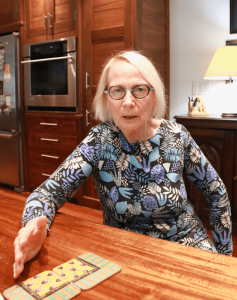
“I was hired back to solve a problem with processing consolidated loans. I didn’t know anything about consolidated loans,” she said. “I figured it out. I asked for enough help, and there were enough people around who really helped and were able to get the project done. That started my career, basically.”
She was presented with a problem.
She thought about it.
She started asking questions.
She asked for help from people who could provide it.
She saw through to the issues and made a plan, tested and executed it.
That’s classic consulting.
And now Suzanne had a reputation.
“Every 18 months they moved me from one department to another as a problem-solver, troubleshooter. I found enough people to help. We started software testing for a project. The auditors had come in and said, ‘Citibank can’t put this system in. You need someone to do testing.’ So they came to me, I said, ‘What’s testing?’ A kind man helped me with that.
“Then they asked me to do other things. I became part of the collections group and I didn’t know anything about collections.”
How did she succeed where others were stymied?
“I look at things from a different angle,” she said. “If you don’t know anything about something, you sort of have to ask, ‘What is it and how do you look at it and how do you do that?’ And you need to have people who will tolerate that. I’ve been very lucky in my life.”
She ended up being tapped for the Citibank Corporate Challenge, and went literally all over the world for a month with a team of eight people — including a former CIA leader from the Clinton administration who taught Suzanne to speak slowly and softly, with few words, so people tuned in to her message.
At the end of the challenge, she argued her team’s position on a program senior leadership was prepared to can, and the program was renewed.
“That’s when I decided I really wanted to be a consultant,” she said.
“Cultural change was a really big thing at Citibank. I found I really didn’t understand change when I was trying to affect it. I was very protective of what I had developed and then I didn’t remain open to new thinking.
“I thought, ‘This really has to change in my own world.’ I had to have the belief and a way of thinking that change is really good: ‘how can we help each other instead of fighting and competing with each other?’”
In a conservative corporation, like a bank, change is like dragging a concrete block across a highway.
“When you get high-achieving people and get them out of thinking ‘I, I, I’ and start thinking of ‘us’ or ‘we,’ it’s very difficult,” she said.
“My first gig, I was on the board at Harley School. We sent our kids to Harley. Our son, Marc, who taught himself how to read, was a quirky kid and not going to do well in a large school,” she said. “We sent them to Harley, where they learned how to talk to adults and ask for help and were able to defend a position. That’s something I wish I had learned at that age.”
At Harley, she helped raise money, and Sandy became involved in a summer Horizons program. And she was now earning money as a consultant with her own company, Sirius Change. Seneca Foods head Kraig Kayser tapped Suzanne for a succession-planning and strategic-planning project. Neighbor Mark Kindig asked her to help with training at his start-up, M2 Methods, and Suzanne brought in Marc to help animate training products.
Next, she became acting director at the Lacy Katzen law firm.
“In a law firm, you’re selling knowledge, but you’re doing the same thing over and over and over,” she said. “They tried to find technology that would make things easier and make their lives more efficient and effective so they could move around.
“Then it was finding people who really believed in that, and invest in them. It makes a big difference, because you make more money and are more customer-service oriented.
“I stayed there a long time. We did some change there. Lawyers are trained to learn something very quickly and then argue it to death. Trying to influence them was a big study in, ‘How do you do that?’”
Exploring ‘place-making’
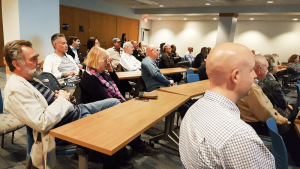
Daughter Brook got mom interested in the Rochester Regional Community Design Center. Two architects, Johnny Monroe and Roger Brown, had started it to increase the city’s use of “place-making,” developing vibrant spaces that give a community-within-a-community feel.
“They believed in making Rochester different, planning it with good design. They brought in experts from the outside, educated the community with what they were doing, and did charrettes (intensive planning or information-gathering sessions) with different neighborhoods,” Suzanne said.
She worked with Environmental Energy Technologies on ways to make diesel fuel cleaner, with Women’s Gynecology and Childbirth Association on a new health care system rollout, and with friend Andy Germanow at GS Plastics Optics and Tel Tru, blending new-school and old-school companies through cultural change.
“What has to happen is a bite of the elephant,” said. “Most of the time people bring you in for some kind of project they think is the issue. And you’ll say, ‘Yes, that’s your issue, but there’s also A, B, C and D over here. Let’s start here and see where that leads to.’
“There are V-8 moments, like the ‘I could have had a V-8’ kind of thing. Managers can have that. Heads of companies can have that. My job is to say, ‘I disagree with you. I think you have to think about this,’” Suzanne said.
When she saw the transformations the design center could light up, she became sold on urbanism, and found out how successful she could be right in her own back yard at Grove Place, where she and her neighborhood have done some place-making.
“That’s where I became an activist, by asking what do we need to know, how do we get involved, and what is going to affect our lives,” she said. Grove Place worked a down-zoning change inside the Rochester downtown, creating its own mini-neighborhood.
Next came the Center City Community Coalition, or C4.
“We were trying to talk about all the residents who live downtown. They decided residents needed a voice. I was working with people I’d never worked with before. That was with Jeremy Cooney, chief of staff for mayor Kim Russell, in our neighborhood, and working with Home Leasing, who got involved with the design center. Two people from Washington Square neighborhood came in. Then we asked Randy Morganstern from the St. Paul area.
“How do we get residents involved? How do we get city council to realize that downtown is not represented by any single council members, but by all of them, really? We had to raise the awareness that you have new people coming down here and they’re active.”
The organization fleshed out plans and when the city planners got involved, they found out C4 had gone beyond the city’s cookie-cutter resolution strategies and was demanding more.
From this then grew Hinge Neighborhoods, an organization dedicated to do place-making in the former inner loop area.
“The previous mayor didn’t get involved with the community about what was going to be there, what would it look like, after they filled it in,” Suzanne said. “We wanted to know what was going to be there and how were the streets going to be made. The design center got involved, with a lot of secret meetings going on to sort of influence how they were going to bring it up to street level and actually make it part of the city.
“They were just going to fill it in. We wanted that put to good use. We were able to get a bike lane put in, and planning for the future. I really watched that. It was wonderful.”
She criticizes the city for falling back on a request for proposal process to look for ideas on what to do with the area, rather than seeing what residents and businesses actually want.
“It becomes the developer who decides what’s going to go in there. I learned that from the casino that was proposed for downtown — and Parcel 5 is still in an RFP process, and still a problem. We’re a city that reacts instead of being proactive.”
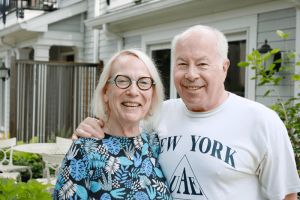
Hinge Neighborhoods was born through Suzanne partnering with Shawn Dunwoody, each person on a different side of the area, each recognizing and introducing the unique needs and interests of their neighborhoods.
“He’s from that side; I’m from this side,” she said. “The two neighborhoods don’t speak. Now we’re going to take this road away that separated us. We’re going to be together. What are we going to do about it? We started to be proactive — how do we get people involved? The city would go to neighborhood associations, but you look at Grove Place, and we’re one of the most active citizen groups around. We’ll get involved; I’m not worried about us. Someone will listen to us.”
The objective is to make Hinge Neighborhoods active and knowledgeable, and that means getting a large group of residents — renters — involved and caring.
And that’s what Suzanne Mayer is working on right now. In particular, the group is looking for funding for a feasibility study of what can be done in the “hinge” area.
“We’ve had a lot of doors closed, but a lot of open doors because we’ve talked to so many people,” Suzanne said. “Right now we’re talking to the city to see what kind of support they’re going to give us. They want us to change our scope and we don’t know how we’re going to react to that.”
Suzanne Mayer doesn’t back up. She keeps working, keeps networking, keeps thinking about plans and ideas.
Where does she get the energy?
“I don’t have a lot of free time,” she admits. “I play tennis once or twice a week. I exercise. Sandy and I walk as much as we can. In the winter, I walk the Mount Hope Cemetery, right by Susan B. Anthony and Frederick Douglass.”
She said that although “we’re not club people,” she joined the Genesee Valley Club. “I can exercise there, and if I can’t get people to meet with me anywhere else, they’ll come to the Genesee Valley Club.”
Suzanne also favors the Orange Glory shop next to the Little Theatre. “You can get people to meet with you in a coffee shop who won’t meet with you in City Hall,” she said.
Either you absorb a city or it devours you. You work the processes available or make new ones. Suzanne Mayer and her husband, Sandy, love Rochester, love the thrum of its energy, and admire the vitality of its people.
And they are working very hard to make the Flower City a better place, neighborhood-by-neighborhood, place-by-place.

